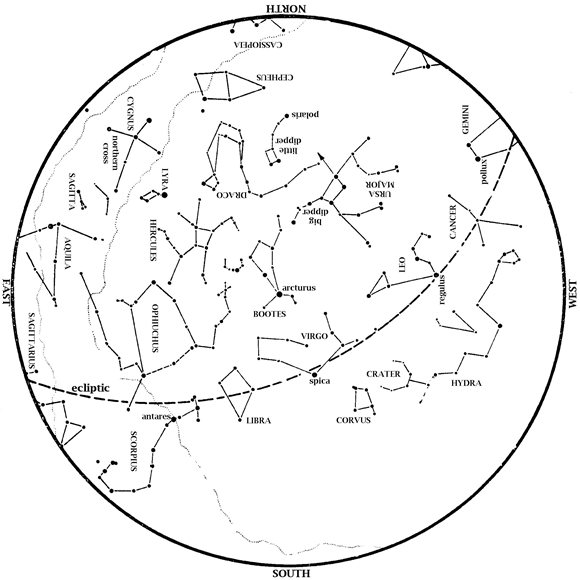Editor’s Note: The July summer heat is not cooling off any time soon and HMNS Astronomer James Wooten is here to explain why that is.
Saturn is in the south-southwest at dawn.
Mars is also in the morning sky, in the east at dawn. Mars brightens each morning this month as it approaches Jupiter.
Venus is lost in the Sun’s glare and out of sight this month.
Jupiter is in the east at dawn and outshines all the stars we ever see at night.
Spring stars are high in the south and west. A distinct backwards question mark shape outlines the mane and forepaws of Leo, the Lion. Three stars forming a right triangle are to its upper left; they mark Leo’s hindquarters. The Big Dipper is as high as it ever gets in the north at dusk. You can extend the curve of its handle to ‘arc to Arcturus’ and then ‘speed on to Spica’. These stars high in the east and south, respectively, by dusk tonight. Arcturus, by the way, is the fourth brightest star we ever see at night, but the brightest one Americans ever see in all of July.
In the east, look for the enormous Summer Triangle, consisting of the stars Deneb, Vega, and Altair. This triangle is up all night long in July, hence its name. Scorpius, the Scorpion, is in the south at dusk. Sagittarius, the Archer, known for its ‘teapot’ asterism, is to Scorpius’ left.
Between Boötes (which contains Arcturus) and Hercules on the star map are stars in a small semi-circle. This is Corona Borealis, the Northern Crown. The star T Coronae Borealis is not normally visible to the naked eye, but about every 80 years it brightens as a nova. That’s because it’s really two stars: a red giant and a white dwarf. When mass falls off of the red giant onto the white dwarf, that dwarf briefly glows much brighter. We call that a nova. This last happened in 1946, so it’s due again by 2026. However, light from T Coronae Borealis has recently behaved just like it did right before the 1946 nova. Therefore, astronomers predict we might see the nova this summer, even though it’s a little early. Note that this is not a supernova—a stellar explosion sometimes bright enough to see in daylight. When this happens, a star normally way too dim for us to see will gain average brightness; you’ll just see an extra star in the ‘crown’.

The Summer Triangle is high in the east. This consists of the brightest stars in Cygnus, Lyra, and Aquila. Scorpius, the Scorpion, is in the south, with the ‘teapot’ of Sagittarius to his left. Leo, the Lion, sets in the west. From the Big Dipper’s handle, ‘arc to Arcturus’ and ‘speed on to Spica’ in the southwest.
Moon Phases in July 2024
New July 5, 5:57 p.m.
1st Quarter July 13, 5:49 p.m.
Full July 21, 5:17 p.m.
Last Quarter July 27, 9:51 pm
At 12:06 am CDT on Friday, July 5, the Earth is at aphelion, which means it is as far away from the Sun as it will get this year. That greater distance is not doing much to cool us off, however. Why not? Bear in mind that Earth’s orbit is almost a perfect circle, with an eccentricity (out of roundness) of only 1.6%. This variation in the Earth-Sun distance is too small to affect our weather. Earth’s 23.44 degree tilt produces a much bigger effect. Our hemisphere is very much tilted towards the Sun in July, so we swelter in summer heat.
Our George Observatory is now open every Saturday night for observing! Purchase tickets in advance on our website.
Clear Skies!
Looking for June’s sky happenings? Click here.






